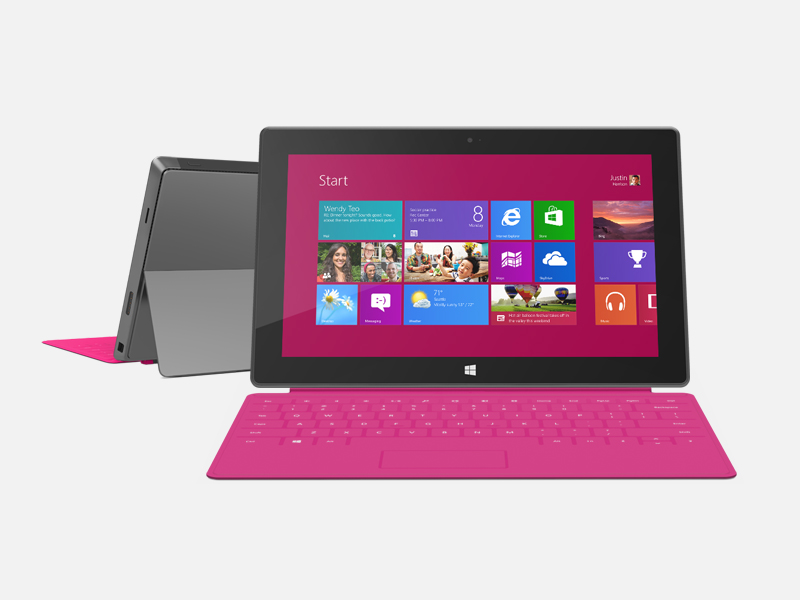IPads are already making their way into businesses via bring-your-own-device efforts with Microsoft Surface RT tablets hoping to follow suit as employees lobby for their favorite devices. But which one makes more sense from an IT perspective?
Read Network World’s other tech arguments.
The two products are roughly similar in price ($500), run touch-centric operating systems, are highly portable and weigh about a pound and a half.

The two most significant differences are that Surface RT comes with both a keyboard and a version of Microsoft Office – Office 2013 Home & Student 2013 RT – which expand the potential corporate utility of the devices.
Third-party keyboards are available for iPads as are third-party versions of Office-compatible productivity suites but they represent more work for IT. A rumor says Microsoft is working on a client that will allow accessing Office from an iPad through Microsoft’s service Office 365.
Office on Surface RT has its limitations. It lacks Outlook but includes Word, Excel, PowerPoint and OneNote, and the Surface RT version requires a business license in order to be used for work. Still, having it installed out of the box is a leg up and gives workers the opportunity to tap into the productivity suite. The keyboard is a big plus.
Bullet Apple iOS vs. Google Android: It comes down to security
Bullet Cisco, VMware and OpenFlow fragment SDNs
Bullet Cloud computing showdown: Amazon vs. Rackspace (OpenStack) vs. Microsoft vs. Google
Bullet Cisco Catalyst 6500 vs. Cisco Nexus 700
When it comes to numbers of applications iPad has far more than Surface RT, and neither one has the number of business applications that support traditional Windows operating systems. Surface RT is a Windows operating system that can’t run traditional Windows apps except for the Office suite specifically crafted for the platform.
Instead, Surface RT has its own class of applications called Windows Store apps, mainly because they can only be bought from the Window Store. They are tailored for touch tablets and must be vetted by Microsoft before they get into the store’s inventory.
They can be developed using XAML, with code-behind in C++, C#, or Visual Basic, and Microsoft has a provision for sideloading custom business apps to Surface RT without submitting them first to Microsoft. Even so, that’s a lot of work to get apps natively on the devices.
Both iPads and Surfaces support virtual desktops, which goes a long way toward making traditional apps available on them. Hosted virtual desktops (HVD) can be costly, Gartner says in a report called “Bring Your Own Device: New Opportunities, New Challenges”. Its research found that “shifting to an HVD model increases the onetime costs per device by more than $600.” Plus proper licensing of iPads for business use is complicated, the report says.
Managing Surface RT is possible via Windows cloud-based management Intune and Exchange ActiveSync for messaging. IPad also supports Exchange ActiveSync. Third-party mobile device management platforms can configure and update iPads as well as monitor compliance with corporate policies. They can also wipe or lock lost and stolen machines. OS X server can do all this as well.
Surface RT comes with security features iPad doesn’t. These include both hardware-based secure boot that checks that the system hasn’t been tampered with and also trusted boot that fires up anti-malware before anything else. That way malware can’t disable the anti-malware before it gets the chance to do its job. The same hardware security module can act as a smartcard for authentication, and Surface RT has full disk encryption.
The iPad has disk encryption but lacks the secure boot features of Surface RT. Its secure boot chain is based on read-only memory and its hardware security module doesn’t do double duty as a smartcard.
NOTE: There is another version of Surface that runs on x86 processors and supports any application that Windows 7 supports. It’s not available until next year, but is actually a tablet-sized full Windows laptop with all the touch capabilities of Surface RT.
That device would beat iPad hands-down if it cost the same, but it is likely to cost hundreds of dollars more than Surface RT.
Best Microsoft MCTS Certification, Microsoft MCITP Training at certkingdom.com
